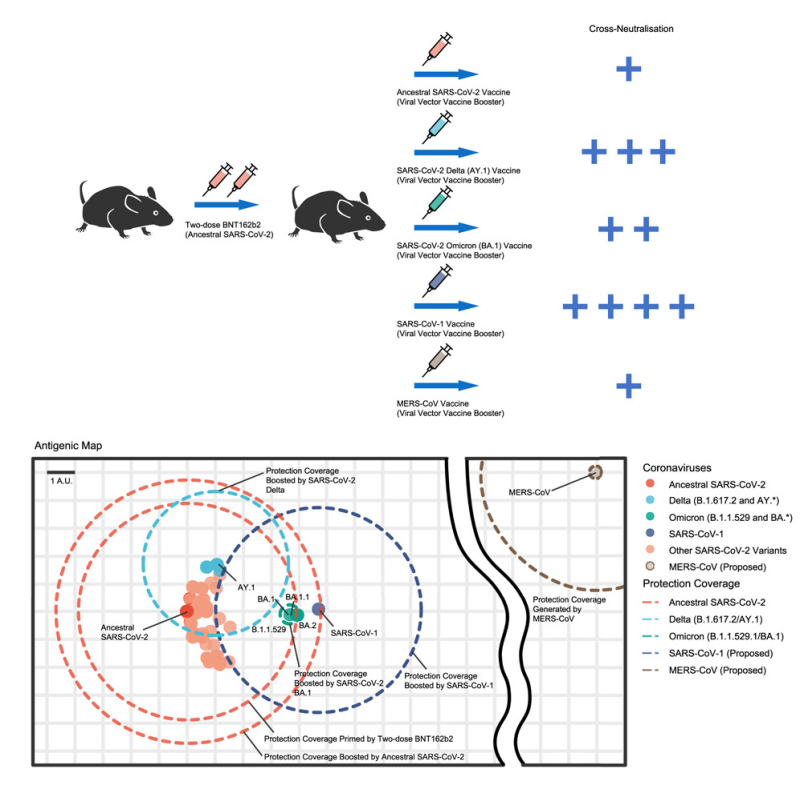Quantitative Biological Strategy Helps to Upgrade Vaccines against COVID-19
Date:04-08-2023 | 【Print】 【close】
Researchers from the Shenzhen Institute of Advanced Technology (SIAT) of the Chinese Academy of Sciences (CAS) and the University of Hong Kong, along with their collaborators, have proposed a promising quantitative biological strategy for dynamic updates of vaccine against SARS-CoV-2 virus. They demonstrated that a vaccine based on the ancestral SARS-CoV-1 strain could offer more extended and broader protection than other options.
The study was published in Cell Host & Microbe on July 31.
Over the past three years, scientists around the world have developed vaccines against the virus. Initially, most vaccines demonstrated high effectiveness in preventing COVID-19. While the protection levels of all vaccines declined over time or due to newly emerged variants. Thus, a COVID-19 booster shot is recommended to people who have already completed their initial vaccine series. Such a booster vaccine can increase protective immunity back to protective levels. However, the evolution of SARS-CoV-2 virus demands a new strategy for developing new vaccines to keep up.
The process of developing and testing vaccines often lags behind the emergence of new variants. For example, the Omicron strain (B.1.1.529/BA.1) surfaced in November 2021, but the second-phase clinical trial of the vaccine targeting the BA.1 strain only began in February 2022. By April 2022, during the mid-term analysis, the strain had evolved into BA.2, and by September 2022, it had already become BA.5.
Based on research and analysis of immune escape of SARS-CoV-2 virus, the researchers constructed an "antigen distance" model using existing neutralization and sequencing data. This model measured the degree of immune escape between different mutant strains based on the neutralizing abilities of human sera against various strains.
They plotted an antigen map of COVID-19 in terms of "antigenic distance" and explored the protection range of using different strains as booster vaccines, including the ancestral SARS-CoV-2 strain, the SARS-CoV-2 Delta strain (B.1.617.2/AY.1), the SARS-CoV-2 Omicron strain (B.1.1.529/BA.1), the SARS-CoV-1 strain, and the Middle East respiratory syndrome coronavirus (MERS-CoV) strain. The results demonstrated that a booster vaccine based on the SARS-CoV-1 strain might provide more extensive and durable protection against COVID-19 compared to the Delta and Omicron strains.
To validate their findings, the researchers conducted experiments using human serum samples, which confirmed the model's accuracy. Subsequently, they tested the model in a mouse model. Mice were given two doses of mRNA vaccine followed by different strains as booster shots. The results showed that the SARS-CoV-1 booster shot outperformed other candidate vaccines in terms of specific antibody levels, neutralizing antibody levels, and protection durability. In live virus challenge tests, the SARS-CoV-1 booster also provided superior protection.
This study suggests that designing new COVID-19 booster shots based on antigen distance could be a valuable approach to tackle emerging SARS-CoV-2 variants. Based on the "antigenic distance", the researchers can generate a region in which each point (variant) has a vaccine efficacy associated with it. In the Discussion of the paper, the researchers proposed a new concept called the "antigen field" to better understand and quantify the interactions (immune responses) between the human immune system and foreign antigens. This concept is similar to an "electric field" and refers to the fundamental interactions diffused within the immune space. Infection or administration of a specific antigen generates an "antigen field." After its activation, this antigen field can "repel" subsequent antigens attempting to enter the same field or antigens that are in close proximity to the initial antigen in terms of antigenic distance. The proposed "antigenic field" concept opens new avenues for understanding the immune system's interaction with foreign antigens, potentially influencing future vaccine and immunotherapy development.

Antigenic map of the new crown and range of protective power of different vaccine strains. (Image by SIAT)
Media Contact:
ZHANG Xiaomin
Email:xm.zhang@siat.ac.cn